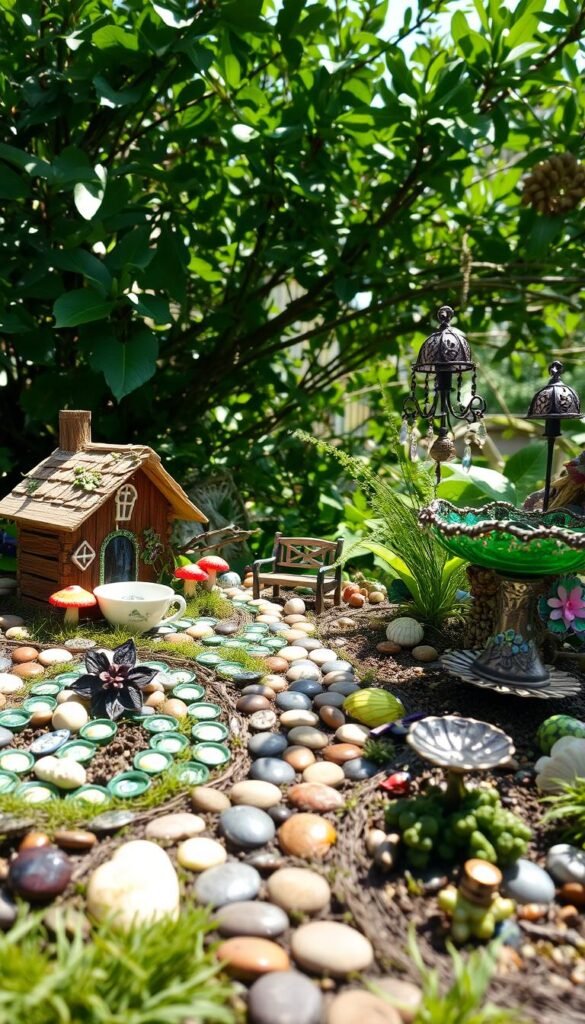Imagine transforming ordinary objects into extraordinary tiny worlds that spark joy and creativity. Building miniature landscapes lets you design unique spaces brimming with personality while saving money through clever material reuse. This hands-on activity offers more than just decoration – it becomes a therapeutic escape that invites families to bond over shared imagination.
Unlike store-bought decorations, handmade creations tell personal stories through every carefully placed detail. By adopting a playful perspective – envisioning how small creatures might use everyday resources – you’ll discover surprising ways to repurpose materials like buttons, bottle caps, and fabric scraps. Our guide to budget-friendly container ideas shows how simple transformations can yield magical results.
The process naturally encourages sustainable practices as you give new life to overlooked items. Children and adults alike find calm focus while crafting delicate accessories, making this hobby ideal for mixed-age groups. Each finished piece becomes an irreplaceable treasure that evolves with your growing vision.
Through this creative journey, you’ll develop skills in spatial design and storytelling while reducing household waste. The satisfaction of completing tiny furniture or miniature pathways rivals that of larger projects, proving good things truly come in small packages.
Introduction to Whimsical Fairy Gardens
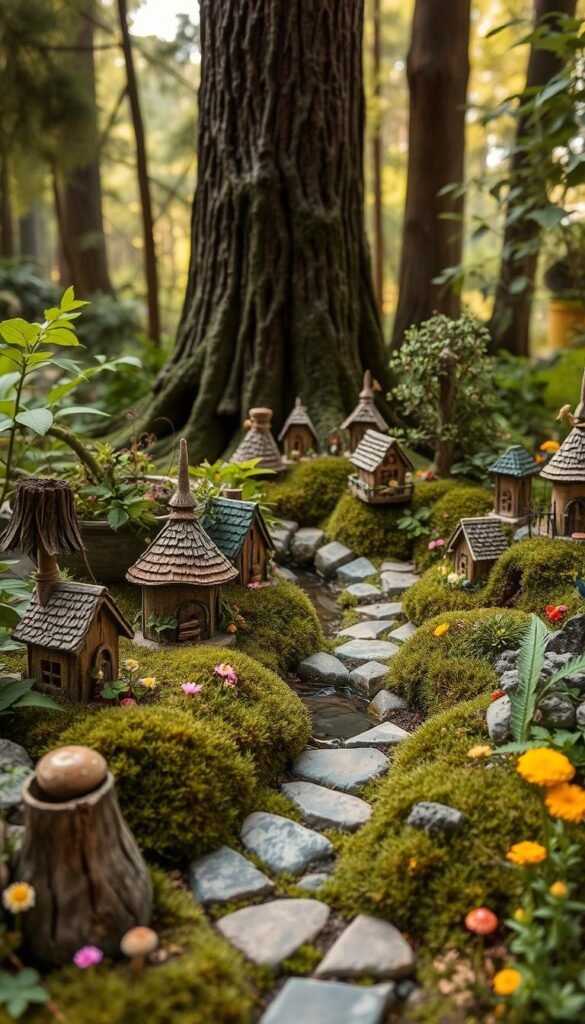
Unlock the door to miniature marvels that turn simple nooks into storybook escapes. These curated spaces blend natural elements with playful design, creating interactive displays that feel alive with possibility. Whether on a windowsill or under a tree, they offer daily doses of wonder through careful arrangement of tiny features.
What Makes These Tiny Worlds Special?
The magic lies in storytelling through design. A cracked teacup becomes a bubbling pond, while twigs form rustic bridges. By working in 1:12 scale, you create environments where acorn caps serve as bowls and pebbles transform into stepping stones. This perspective shift turns ordinary items into extraordinary scene elements.
“Building these worlds reminds us that beauty exists in the smallest details – if we take time to look.”
Crafting Believable Miniature Environments
Successful setups balance realism with fantasy. Consider these essential components for indoor and outdoor spaces:
| Element | Outdoor | Indoor |
|---|---|---|
| Ground Cover | Moss | Colored sand |
| Water Features | Shallow dishes | Mirror tiles |
| Lighting | Solar lamps | LED string lights |
| Seasonal Touches | Maple seeds | Fabric snow |
Urban dwellers often use terrariums for contained ecosystems, while suburban creators might section off garden corners. The key is maintaining proportion – oversized elements break the illusion. Mix living plants with crafted accessories for dynamic displays that change with time.
Discovering the Charm of DIY Fairy Accessories
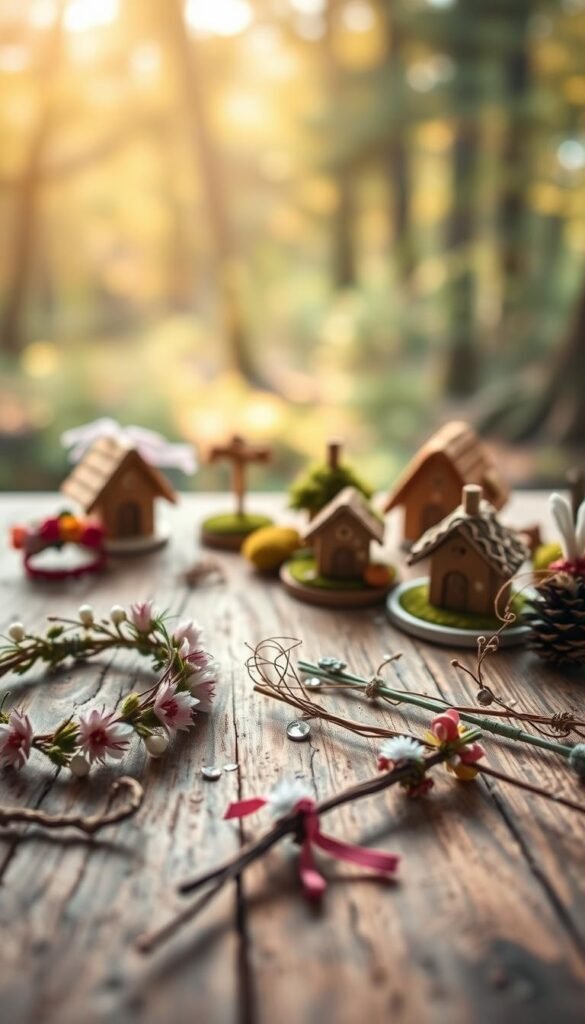
There’s magic in crafting tiny treasures that tell your story. Unlike generic store-bought pieces, handmade creations carry fingerprints of imagination – a button-turned-table or seashell bathtub reveals more personality than any factory-made item.
Why Handmade Beats Mass-Produced
Customization rules when making miniature decor. Choose colors matching your theme or resize elements to fit unique spaces. A craft blogger notes: “Store displays feel sterile – yours should whisper secrets only your family knows.”
Creativity Through Resourcefulness
Transforming bottle caps into swings teaches inventive thinking. This process:
- Sharpens problem-solving skills
- Encourages material experimentation
- Builds artistic confidence through small wins
Families bond while brainstorming uses for fabric scraps or beads. The focused work becomes meditative – shaping clay mushrooms or painting tiny signs creates calm moments away from screens.
Best part? Mistakes become happy accidents. Crooked fences add whimsy, while mismatched colors inspire new themes. Every imperfect piece holds memories no perfect decoration ever could.
Transforming Common Household Items into Fairy Treasures
Turn forgotten corners of your home into magical realms where everyday objects become enchanted artifacts. The secret lies in adopting a miniature mindset – seeing paperclips as trellises or thimbles as flower pots. As one craft blogger puts it: “The best creations happen when you squat down to mouse-eye level and ask: What would tiny beings need?”
Start by hunting for potential treasures. Bottle caps become patio tables with painted designs. Broken jewelry transforms into shimmering pathways. Even kitchen tools like measuring spoons can be repurposed as decorative ponds. The key is balancing rough-textured natural elements with polished accents for authentic charm.
Try these simple modifications:
- Turn plastic containers into hanging planters using twine
- Convert old keys into whimsical signposts with numbered tags
- Shape cookie cutters into arched gateways with moss details
While clay offers flexibility for custom pieces, found materials often create surprising magic. A rusted hinge becomes a weathered bench, while wine corks stack into rustic steps. This approach aligns perfectly with sustainable crafting methods, turning potential waste into wonder.
The real joy comes in the hunt – spotting a seashell that becomes a bathtub or buttons that form stepping stones. Each transformation teaches creative problem-solving while building environments that feel truly lived-in. Before long, you’ll see hidden potential in every drawer and shelf.
Step-by-Step Guide to Crafting Your Fairy Garden
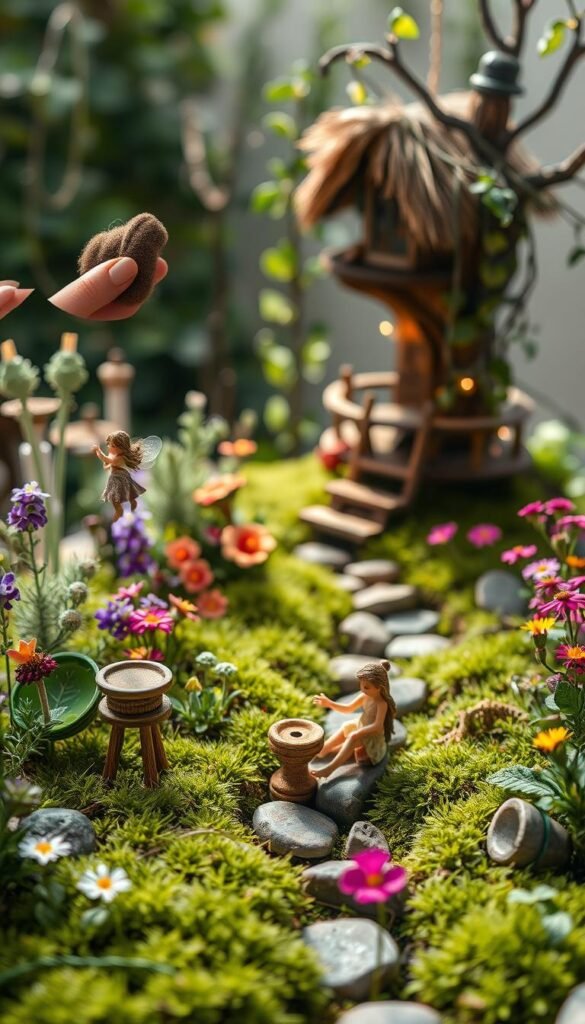
Building your tiny wonderland starts with smart preparation. Focus on creating 1-2 key pieces first, like a cozy bench or sparkling pond. This focused approach keeps projects manageable while building confidence.
Smart Preparation Essentials
Begin by choosing projects matching your skill level. A seasoned crafter suggests: “Your workspace should inspire creativity – keep tools within reach and surfaces clutter-free.” Use this starter kit:
| Category | Natural | Repurposed | Store-Bought |
|---|---|---|---|
| Building | Twigs | Bottle caps | Modeling clay |
| Decor | Pebbles | Broken jewelry | Fish tank marbles |
| Tools | Pinecones | Thimbles | Pipe cleaners |
Dollar stores offer most supplies – think small mirrors for ponds or craft foam for roofing. Clean repurposed items with mild soap before use.
Effortless Construction Methods
Master these three techniques for multiple projects:
1. The Dot Method: Use hot glue in pea-sized amounts for quick adhesion without mess
2. Color Blending: Mix acrylic paints on wax paper for custom shades
3. Texture Tricks: Press lace into clay or sprinkle sand on wet paint for realism
Keep sharp tools in locked containers if crafting with kids. Adjust complexity by swapping materials – use pre-made fences instead of carving wood for beginners. The joy comes from progress, not perfection.
Innovative Ideas for Fairy Garden Flowerpots and Succulents
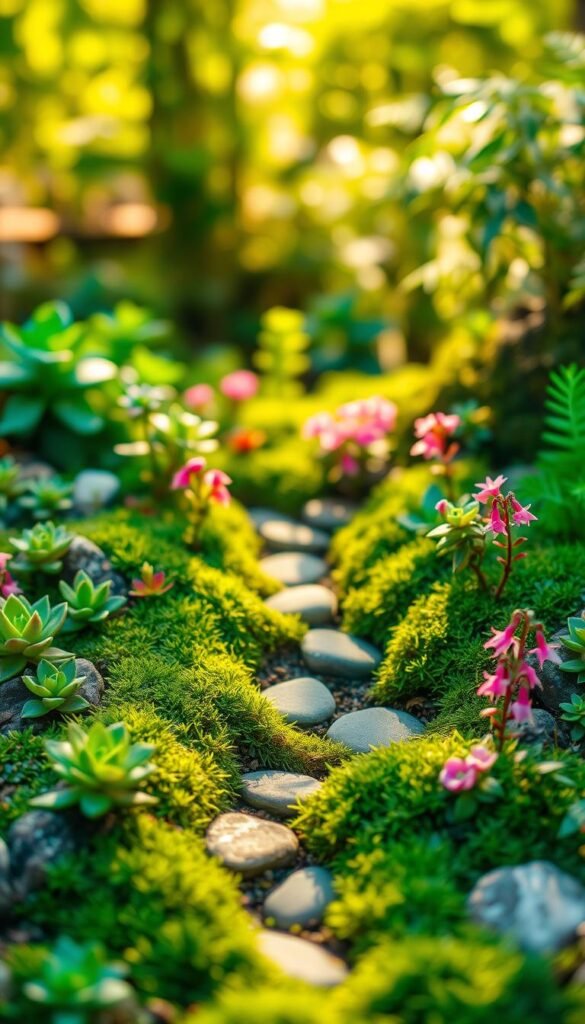
Bring your miniature landscapes to life with vibrant flora that thrives in tiny spaces. Start by crafting eye-catching containers – store-bought clay pots become instant charm when filled with preserved blooms. For rustic appeal, hollowed walnut shells or smoothed stones make perfect natural planters.
Polymer clay lets you design everlasting greenery. Shape tiny succulents using simple tools – a toothpick creates realistic leaf textures. These handmade pieces never wilt, making them ideal for busy creators. Pair them with real moss for contrast that pops.
Live plants add authenticity to your displays. Air plants thrive without soil, while Irish moss forms velvety carpets. Use this guide to balance living and crafted elements:
| Plant Type | Benefits | Best Uses |
|---|---|---|
| Preserved Flowers | No watering needed | Seasonal accents |
| Clay Succulents | Permanent color | Focal points |
| Living Moss | Natural growth | Ground cover |
| Air Plants | Low maintenance | Hanging features |
Rotate elements with the seasons – sprinkle dried lavender buds for summer or add miniature pumpkins in fall. A gardening enthusiast notes: “Mixing real and crafted botanicals lets you control the scene’s energy while keeping care simple.”
Arrange taller specimens at the back to create depth. Cluster three flowers of varying heights for visual interest. Remember – odd numbers feel more natural in small-scale designs.
Designing Enchanting Fairy Houses and Mini Structures
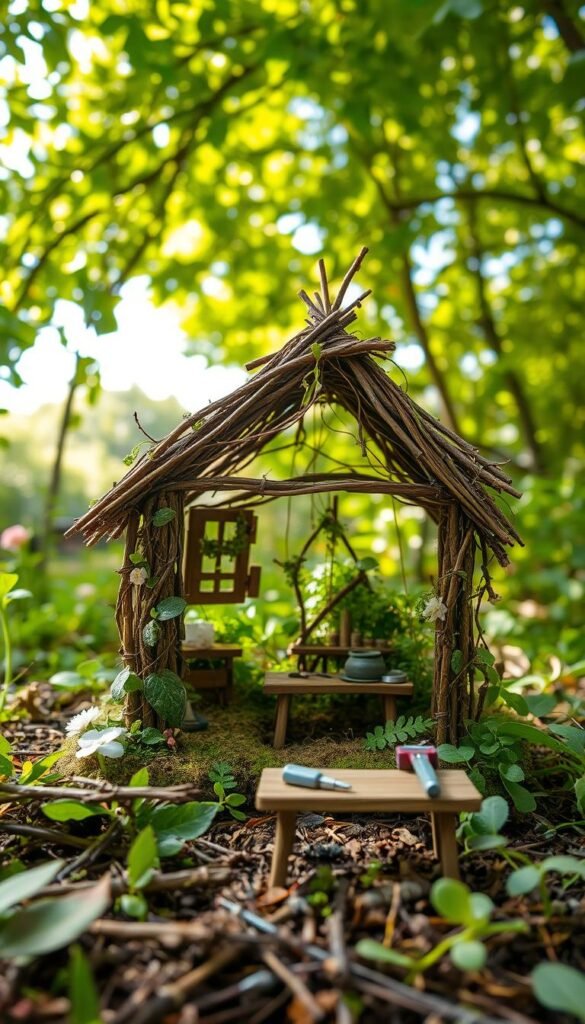
Crafting miniature homes transforms ordinary materials into storybook dwellings. With simple techniques, you’ll build charming hideaways that blend craftsmanship with imagination. Let’s explore two approaches to creating tiny architecture that sparks wonder.
Building With Sticks and Clay
Popsicle sticks become sturdy walls when glued in crisscross patterns. Seal gaps with wood filler before painting weathered textures. For curved roofs, mold polymer clay over soup cans – bake at 275°F for 15 minutes to harden.
Try these material combinations for different styles:
| Material | Best For | Weather Resistance |
|---|---|---|
| Popsicle Sticks | Cabin Style | Indoor Use |
| Polymer Clay | Cottage Shapes | Waterproof |
| Flat Stones | Stone Cottages | Outdoor Ready |
| Concrete Mix | Modern Designs | All Conditions |
Treasures From Unexpected Places
Turn thrift store finds into unique features. An old birdhouse becomes a concrete masterpiece when coated in mortar mix. Plastic containers morph into turrets with textured paint. As one creator notes: “The best houses have character – dents and scratches tell better stories than perfection.”
Discover more creative structure ideas using items you already own. Try bark shingles for roofing or bottle-cap chimneys. Each addition makes your tiny home feel lived-in and magical.
Fairy Garden Crafts DIY: Repurposing Common Household Items
Your kitchen drawer holds secrets to enchanting miniature realms waiting to be discovered. Those champagne bottle caps collecting dust? They become bistro chairs with a coat of metallic paint and ribbon cushions. Plastic pizza box supports transform into modern patio tables when flipped upside down and spray-painted. Even pull-tabs from soda cans shine as decorative plant hangers with some creative wirework.
For authentic miniature tools, flatten aluminum cans into shovel blades using protective gloves and tin snips. Always supervise younger crafters when handling sharp edges – safety glasses are non-negotiable. A seasoned creator advises: “Dents and scratches add character – your tiny rake shouldn’t look factory-new!”
Spotting potential in discarded materials becomes second nature. Worn-out buttons make charming stepping stones, while cracked teacups evolve into bubbling fountains with pebble accents. Use these modification techniques:
- Seal painted surfaces with clear nail polish for weather resistance
- Attach mismatched earrings as decorative gate handles
- Layer coffee stirrers into rustic fencing with wood glue
Repurposed creations often outshine store-bought pieces through their unique stories. A hairpin turned trellis or chess piece converted into a lamppost sparks conversations about creative problem-solving. This approach keeps materials from landfills while adding soul to your displays.
Match your upcycled elements to specific themes effortlessly. Metallic bottle caps suit modern spaces, while burlap scraps create cottage charm. The real magic happens when everyday objects disappear into their new roles – leaving pure enchantment in their wake.
Upcycling Everyday Objects into Fairy Furniture and More
Your home holds hidden possibilities for crafting charming tiny furnishings. With simple materials and creative vision, you’ll design pieces that bring character to any small-scale scene. Let’s explore clever ways to transform overlooked items into functional decor.
Crafting With Metal and Plastic
Bottle caps shine as instant seating solutions. Flip them upside down, add painted bamboo skewer legs, and you’ve got chairs perfect for a cozy village square. For matching tables, stack two caps with a soda can ring between them – instant bistro sets!
Discover more detailed tutorials using pizza savers as patio furniture bases. These lightweight creations withstand outdoor conditions when sealed with clear varnish.
Natural Material Magic
Twisted twigs become rustic benches with minimal effort. Select Y-shaped branches for legs, then glue flat wood slices across the top. Sand rough edges gently to keep that handcrafted charm.
For added stability, wrap joints with floral wire before painting. These organic pieces blend seamlessly into natural settings, creating perfect resting spots along pebbled paths.

